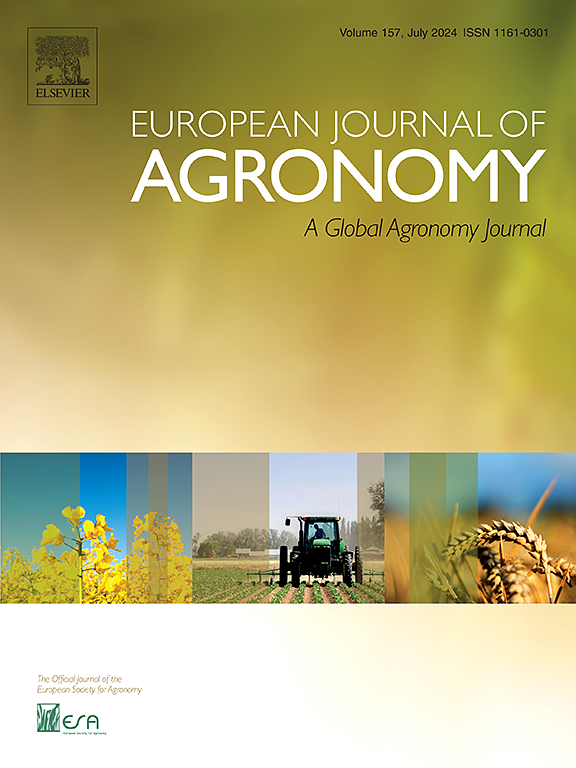Enhancement of soil humic acid hydrophobicity by 5 consecutive years of full-amount straw shallow-mixed field return
IF 4.5
1区 农林科学
Q1 AGRONOMY
引用次数: 0
Abstract
Crop yield is directly influenced by the storage and stabilisation of soil organic carbon (SOC), which is determined by the hydrophobicity of soil humic acid (HA). Changes in soil HA hydrophobicity, humic substances, SOC and crop yield were compared after the application of different amounts of straw returns in the field, and the contribution of straw application in enhancing HA hydrophobicity was examined. The treatments included no straw application and soil stirring, no straw application with soil stirring, application of half-amount straw shallow-mixed field return, application of full-amount straw shallow-mixed field return and application of double-amount straw shallow-mixed field return. Using elemental analysis, infrared spectroscopy and fluorescence spectroscopy, the structural hydrophobicity of soil HA was exhaustively characterised. The results showed that the hydrogen to carbon ratio of HA increased by 11.46 %, the ratio of hydrophobic to hydrophilic intensity increased by 21.02 %, and the ratio of peak B to peak A fluorescence intensity decreased by 32.21 % after 5 years of full amount straw shallow-mixing field return compared to no straw application and soil stirring. The observed results indicate that the augmentation in hydrophobicity stimulates the formation of HA, enhances soil humification, elevates SOC content by 9.78 % and potentially contributes to the ultimate crop yield increase by 22.98 %. Compared with stirring the soil, the contribution rate of applying full amount of straw to increase HA hydrophobicity was 49.57–62.05 %, and the contribution rate to increase SOC and yield were 54.59 % and 76.37 %, respectively. While stirring the soil contributed to increasing hydrophobicity, straw application persisted as the primary factor in enhancing hydrophobicity. The findings of this study have significant implications for understanding the mechanism by which straw improves HA hydrophobicity, thereby facilitating carbon sequestration and increasing crop yield.
连续 5 年全量秸秆浅层混合还田提高土壤腐殖酸疏水性
作物产量直接受土壤有机碳(SOC)的储存和稳定的影响,而土壤有机碳的储存和稳定又取决于土壤腐植酸(HA)的疏水性。在田间施用不同数量的秸秆还田后,比较了土壤腐殖酸疏水性、腐殖质、SOC 和作物产量的变化,并研究了施用秸秆对提高土壤腐殖酸疏水性的贡献。处理包括不施用秸秆和土壤搅拌、不施用秸秆和土壤搅拌、施用半量秸秆浅混还田、施用全量秸秆浅混还田和施用双量秸秆浅混还田。利用元素分析、红外光谱和荧光光谱,对土壤 HA 的疏水性结构进行了详尽的表征。结果表明,与不施秸秆和土壤搅拌相比,全量秸秆浅层搅拌还田 5 年后,HA 的氢碳比增加了 11.46%,疏水性与亲水性强度比增加了 21.02%,B 峰与 A 峰荧光强度比降低了 32.21%。观察结果表明,疏水性的增强促进了 HA 的形成,提高了土壤腐殖化程度,使 SOC 含量提高了 9.78%,并有可能使作物最终增产 22.98%。与搅拌土壤相比,全量施用秸秆对增加 HA 疏水性的贡献率为 49.57-62.05%,对增加 SOC 和产量的贡献率分别为 54.59% 和 76.37%。虽然搅拌土壤有助于增加疏水性,但施用秸秆仍然是增加疏水性的主要因素。这项研究的结果对于了解秸秆改善 HA 疏水性的机制,从而促进碳固存和提高作物产量具有重要意义。
本文章由计算机程序翻译,如有差异,请以英文原文为准。
求助全文
约1分钟内获得全文
求助全文
来源期刊

European Journal of Agronomy
农林科学-农艺学
CiteScore
8.30
自引率
7.70%
发文量
187
审稿时长
4.5 months
期刊介绍:
The European Journal of Agronomy, the official journal of the European Society for Agronomy, publishes original research papers reporting experimental and theoretical contributions to field-based agronomy and crop science. The journal will consider research at the field level for agricultural, horticultural and tree crops, that uses comprehensive and explanatory approaches. The EJA covers the following topics:
crop physiology
crop production and management including irrigation, fertilization and soil management
agroclimatology and modelling
plant-soil relationships
crop quality and post-harvest physiology
farming and cropping systems
agroecosystems and the environment
crop-weed interactions and management
organic farming
horticultural crops
papers from the European Society for Agronomy bi-annual meetings
In determining the suitability of submitted articles for publication, particular scrutiny is placed on the degree of novelty and significance of the research and the extent to which it adds to existing knowledge in agronomy.
 求助内容:
求助内容: 应助结果提醒方式:
应助结果提醒方式:


